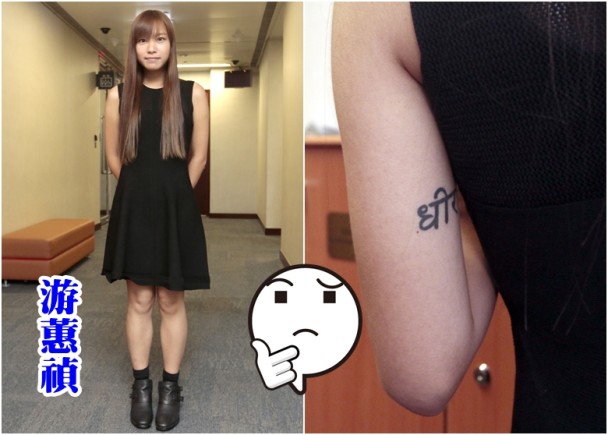A Sanskrit tattoo in Hong Kong
« previous post | next post »
This is Yau Wai-ching 游蕙禎 (b. 1991), a member of the localist political group Youngspiration and a newly elected member of Hong Kong's Legco (Legislative Council):
Here is the story (in Chinese) and the source of the above photographs.
What we see on the inside of the upper left arm of Ms. Yau is dhīra धीर. Definitions from spokensanskrit.de: "brave, composed, resolute, self-possessed, firm, well-bred, persevering, low, deep, persistent, skilful, bold, gentle, perseverant, well-conducted, thoughtful, dull, constant, soft, grave, calm, wise, energetic, steady, courageous, intelligent, clever, steadfast, strong, familiar with, versed in, strong-minded." Compare the results from the Cologne Digital Sanskrit Lexicon (search under "dhIra").
Since this tattoo is on the arm of a girl, people are asking: should it be feminine dhīrā धीरा instead of dhīra धीर?
Deven Patel:
Yes, ideally it should be the feminine form with the long a.
George Cardona:
Yes. On the other hand, most speakers of modern Indo-Aryan languages in the midlands and westward would pronounce the second syllable with a long vowel even if this is not indicated in writing unless they dropped the vowel.
Frederick Smith:
It’s possible that there’s something hidden by the curvature of her arm. But when it comes to tattoos, I have seen many Sanskrit and other faux Indic tattoos. They’re virtually all done by tattoo artists who know nothing of any Indian script but are good at copying what the client gives them, and I would guess that 99.9% of the clients don’t know a single syllable of any Indian language. Chinese tattoos must fall along the same percentages, ever since Philadelphia’s own Allen Iverson showed up with Chinese tattoos on his neck twenty years ago. Someone walked off the street into my office a couple of years ago (not a student) and asked me for the five Buddhist virtues in Sanskrit (devanāgarī) to have tattooed on his back. I told him I would not give it to him unless he promised to put them on his chest, because he needed them where at least he could see them.
All of the definitions cited above are adjectives, but there is also a feminine noun, dhīrā धीरा, which means: "woman who keeps down all expression of resentment or jealousy".
Regardless of grammatical gender, part of speech, and definition, the sheer appearance of a Sanskrit tattoo on the arm of a Hong Kong legislator is worthy of note.
[Thanks to Jichang Lulu]

Y said,
October 4, 2016 @ 2:25 pm
Fortunately, if it needs correcting, that can be easily done by adding a glyph at the end. No erasing necessary.
turang said,
October 4, 2016 @ 3:23 pm
That the word should have been dheeraa assumes that the tattoo is a reference to the person tattooed or another female. It is possible that it refers to a male. I have heard of boyfriends' names tattooed on women, who had to go through a painful process of getting rid of them when the boyfriends no longer were boyfriends.
David B Solnit said,
October 4, 2016 @ 3:58 pm
The same word is not uncommon in Thai personal names, either as the whole name or as one element in it: ธีระ /thiirá/ (the Indic voiced aspirated stop is a voiceless aspirate in Thai).
Jichang Lulu said,
October 5, 2016 @ 4:47 am
Ms Yau continues to make linguistic news, now with a post that uses the Cantonese word 扑嘢 bok1 ye5 'bang' or indeed 'hit'.
Jichang Lulu said,
October 5, 2016 @ 2:03 pm
Oops. Forgot to add the links. Yau's use of 扑嘢 is discussed here in Chinese and here in English.